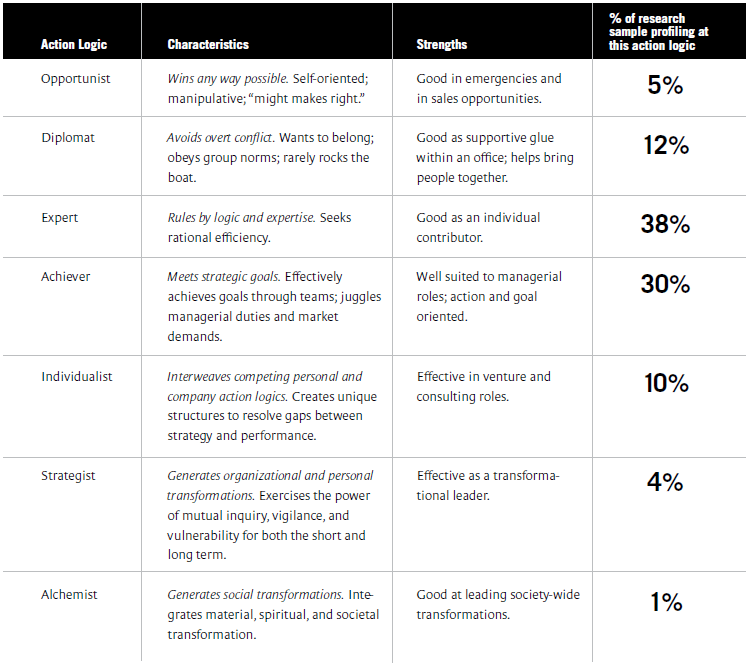Rooke and Torbert: Seven Transformations of Leadership
David Rooke and William Torbert’s model identifies seven stages of leadership. The levels range from “Opportunist” to “Alchemist,” each providing a unique lens to interpret experiences, challenges, and opportunities.
You can see these stages as describing your approach to managing and leading.
The research used an assessment called the ‘Sentence Completion Test’. Participants complete a series of sentence stems such as:
“A good boss _____”,
“Rules are _____”,
“I am _____.”
A reviewer categorizes each sentence based on the characteristics of the seven stages. A report is generated showing which level the responses are at. It then provides ways to grow at your current stage and the next stage.
You can find more information online on how to take the structured assessment. Alternatively, as we are just using these for self-awareness, you can read the descriptions of each category and identify which resonates most with where you are today.
Let’s dive deeper into each stage:

Image courtesy of Harvard Business Review
Opportunist:
Opportunists make up a small percentage of leaders, primarily driven by self-interest, viewing others and situations as means to personal gains. Their actions are driven by a need for control, often resulting in manipulative and exploitative behaviors. Ignoring the broader organizational vision, goals, or culture, they chase personal objectives (which may temporarily align with organizational aims). They can be resistant to feedback and they externalize blame. They may even be quick to retaliate when challenged. This leadership style tends to create stressful work environments, marked by continual crisis, and is generally unsustainable and undesirable in the long run.
Diplomat:
Diplomats are leaders who prioritize group harmony and aim to please those in higher positions while avoiding conflict. They focus more on controlling their own behavior rather than influencing external events or people. Typically found in junior management roles, Diplomats serve as the social glue in teams, paying attention to the needs of others. However, in senior leadership positions, their conflict-avoidant nature becomes problematic. They often struggle with giving challenging feedback and initiating change, preferring to maintain the status quo even when it’s detrimental. This can lead to stagnation and unresolved issues within the organization.
Expert:
Experts make up a significant portion of professionals (38%), driven by a quest for mastery in their knowledge domain. They are usually highly skilled in their domain and rely on hard data and logic to persuade others. They continually pursue perfection and efficiency. While their expertise makes them excellent individual contributors, they often struggle as managers. They are highly certain they’re right, which makes them resistant to alternative viewpoints. This can create a “my-way-or-the-highway” environment, as they often dismiss the opinions of those they consider less knowledgeable. Emotional intelligence is usually not a strong suit for Experts, and they may see collaboration as a waste of time.
Note: One of the biggest constraints organizations face is moving their Experts into Achievers.
Achiever:
Achievers make up 30% of managers and are adept at creating a positive work environment focused on deliverables. They possess a more nuanced understanding of the world compared to lower levels, are open to feedback, and understand that conflicts often arise from different interpretations and ways of relating. Achievers excel in leading teams to implement new strategies over short to medium terms, skillfully balancing immediate and long-term objectives. However, their emphasis on deliverables can sometimes limit creative, out-of-the-box thinking. They often find themselves in conflict with Experts, as both have different approaches to problem-solving and leadership.
Note: 85% of professionals are in the first 4 categories. These are known as the Conventional stages. Leaders here operate mostly within established norms and practices. They tend to see the world through a lens of clearly defined rules and hierarchies. This approach can be successful in well-ordered, predictable environments, but may struggle when confronted with complexity and ambiguity.
Individualist:
Individualists, who make up about 10% of leaders, are aware that all action logics are social constructs. They excel at understanding various ways of relating and communicating well with people operating from different action logics. What sets them apart is their ability to identify conflicts between principles and actions, or between organizational values and their implementation. This tension fuels their creativity and desire for further development. While Individualists can be highly effective, their tendency to ignore rules they see as irrelevant often causes friction within organizations. They challenge conventional norms and may be viewed as wild cards by their colleagues (The challenging aspect of an Individualist is very different compared to the challenging from an Expert or Achiever. The Expert or Achiever will see it as black and white, right and wrong. The Individualist sees past the black and white and right and wrong. They start to ‘see through’ the conventional norms.)
Strategist:
Strategists make up 4% of leaders and stand out for their focus on transformable organizational constraints and perceptions. Unlike Individualists, who excel in communication, Strategists master the second-order impact of actions and agreements. They are adept at creating shared visions that encourage both personal and organizational transformations. Highly effective as change agents, they handle conflict and resistance well. Strategists are intrigued by the interplay at three levels: personal relationships, organizational relations, and broader social developments. They merge idealistic visions with pragmatic actions, aiming for ethical principles and practices that transcend individual or organizational interests.
Alchemist:
Alchemists represent a rare 1% of leaders, distinguished by their ability to reinvent themselves and their organizations in historically impactful ways. Unlike Strategists, who focus on one engagement at a time, Alchemists handle multiple situations across various levels simultaneously. Highly charismatic and morally upright, they are acutely aware individuals with an intense focus on truth. Alchemists excel in capturing unique historical moments for their organizations, employing symbols and metaphors that resonate emotionally and intellectually. They balance immediate priorities with long-term goals, showing exceptional adaptability and the capacity to connect with diverse audiences.
Growing from One Category to the Next:
Transitioning from one leadership stage to the next is a process that includes both personal and professional growth. It begins with self-awareness and a willingness to embrace change and new perspectives.
Each stage reflects a broader and more complex understanding of organizational dynamics, relationships, and the larger societal context in which the business operates. As leaders progress, they develop greater capacities for handling ambiguity, fostering team collaboration, and creating organizational change.
Engaging in reflective practices, seeking feedback, leveraging coaching and developmental opportunities can significantly help in this evolutionary journey.
(Note: The Coach that you hire must be at a higher development stage than the person being coached. The coaching will not be as effective if the hired coach is at the same level or at a lower developmental level.)
Exposure to diverse situations and challenges also serves as a catalyst for advancing to higher stages. As leaders transition through the stages, they not only increase their leadership effectiveness but also contribute more to their organizations’ success and the broader community.
This model serves as a mirror for leaders, enabling them to recognize their current stage, appreciate the strengths it brings, and determine the growth areas to work on.
As individuals navigate through these transformative stages, they not only enhance their leadership style but also increase the capability, adaptability, and resilience of the organizations they lead.
Where are you and where do you want to go?
This model helps in increasing self-awareness about where we are and where we want to go. Read the descriptions of each category and identify which resonates most with where you are today. The level above will be your next development step.
The question then becomes, are you ready to level up?


